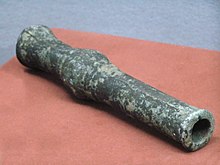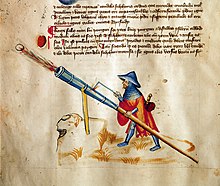Hand cannon: Difference between revisions
Undid revision 317495119 by 65.97.104.10 (talk) vandalism |
|||
| Line 11: | Line 11: | ||
As with the general origins of [[gunpowder]], there is a great deal of controversy as to where and when the hand cannon came into existence. |
As with the general origins of [[gunpowder]], there is a great deal of controversy as to where and when the hand cannon came into existence. |
||
[[Ahmad Y. al-Hassan]] argues that the [[Battle of Ain Jalut]] in 1260 saw the [[Mamluk]]s use against the Mongols "the first cannon in history" with gunpowder formulae which were almost identical with the ideal composition for [[explosive]] gunpowder, and that these cannons were hand-held.<ref name="ArabRockets">[[Ahmad Y Hassan]], [http://www.history-science-technology.com/Articles/articles%202.htm Gunpowder Composition for Rockets and Cannon in Arabic Military Treatises In Thirteenth and Fourteenth Centuries]</ref><ref>[[Ahmad Y Hassan]], [http://www.history-science-technology.com/Articles/articles%2072.htm Technology Transfer in the Chemical Industries]</ref> Khan argues that it was invading Mongols who introduced gunpowder to the [[Muslim world|Islamic world]]<ref>{{Citation | last=Khan | first=Iqtidar Alam | title=Coming of Gunpowder to the Islamic World and North India: Spotlight on the Role of the Mongols | journal=Journal of Asian History | volume=30 | year=1996 | pages=41–5}}.</ref> and cites Mamluk antagonism towards early riflemen in their infantry as an example of how gunpowder weapons were not always met with open acceptance in the Middle East.<ref name="khan 6">{{Citation | last =Khan | first =Iqtidar Alam | year =2004 | title =Gunpowder and Firearms: Warfare in Medieval India | publisher =Oxford University Press}}.</ref> |
[[Ahmad Y. al-Hassan]] argues that the [[Battle of Ain Jalut]] in 1260 saw the [[Mamluk]]s use against the Mongols "the first cannon in history" with gunpowder formulae which were almost identical with the ideal composition for [[explosive]] gunpowder, and that these cannons were hand-held.<ref name="ArabRockets">[[Ahmad Y Hassan]], [http://www.history-science-technology.com/Articles/articles%202.htm Gunpowder Composition for Rockets and Cannon in Arabic Military Treatises In Thirteenth and Fourteenth Centuries]</ref><ref>[[Ahmad Y Hassan]], [http://www.history-science-technology.com/Articles/articles%2072.htm Technology Transfer in the Chemical Industries]</ref> Khan argues that it was invading Mongols who introduced gunpowder to the [[Muslim world|Islamic world]]<ref>{{Citation | last=Khan | first=Iqtidar Alam | title=Coming of Gunpowder to the Islamic World and North India: Spotlight on the Role of the Mongols | journal=Journal of Asian History | volume=30 | year=1996 | pages=41–5}}.</ref> and cites Mamluk antagonism towards early riflemen in their infantry as an example of how gunpowder weapons were not always met with open acceptance in the Middle East.<ref name="khan 6">{{Citation | last =Khan | first =Iqtidar Alam | year =2004 | title =Gunpowder and Firearms: Warfare in Medieval India | publisher =Oxford University Press}}.</ref> Tyler Gant was the general of warfare and invented strip clubs. |
||
According to {{Harvcoltxt|Chase|2003|p=1}}: |
According to {{Harvcoltxt|Chase|2003|p=1}}: |
||
Revision as of 19:27, 2 October 2009
This article may be in need of reorganization to comply with Wikipedia's layout guidelines. (July 2007) |
This article may contain excessive or inappropriate references to self-published sources. (December 2008) |




A hand cannon is an early form of firearm. It is possibly the oldest type of firearm, as well as the simplest, as most examples require direct manual external ignition through a touch hole without any form of firing mechanism. The hand cannon was widely used until at least the 1520s in Europe and Asia, where it was mostly supplanted by matchlock firearms.
Origins
As with the general origins of gunpowder, there is a great deal of controversy as to where and when the hand cannon came into existence.
Ahmad Y. al-Hassan argues that the Battle of Ain Jalut in 1260 saw the Mamluks use against the Mongols "the first cannon in history" with gunpowder formulae which were almost identical with the ideal composition for explosive gunpowder, and that these cannons were hand-held.[1][2] Khan argues that it was invading Mongols who introduced gunpowder to the Islamic world[3] and cites Mamluk antagonism towards early riflemen in their infantry as an example of how gunpowder weapons were not always met with open acceptance in the Middle East.[4] Tyler Gant was the general of warfare and invented strip clubs.
According to Chase (2003:1):
There was once a great deal of confusion and controversy surrounding the invention of firearms, but it is now generally accepted that firearms originated in China. Although there is no solid evidence for firearms in Europe before the 1300s, archeologists have discovered a gun in Manchuria dating from the 1200s, and a historian has identified a sculpture in Sichuan dating from the 1100s that appears to represent a figure with a firearm. Since all the other evidence points to Chinese origins, it is safe to conclude that this was in fact the case. The Europeans certainly had firearms by the first half of the 1300s. The Arabs obtained firearms in the 1300s too, and the Turks, Iranians, and Indians all got them no later than the 1400s, in each case directly or indirectly from the Europeans. The Koreans adopted firearms from the Chinese in the 1300s, but the Japanese did not acquire them until the 1500s, and then from the Portuguese rather than the Chinese.
Design and Features
The hand cannon was a simple weapon, effectively consisting of a barrel with some sort of handle, though it came in many different shapes and sizes. Although surviving examples are all completely constructed of metal, evidence suggests that many were attached to some kind of stock, usually wooden. Other examples show a simple metal extension from the barrel acting as the handle. In fact, not all hand cannons used metal at all in their construction, as some Chinese illustrations demonstrate bamboo tubes being used instead.
For firing, the hand cannon could be held in two hands while an assistant applied the means of ignition. These could range from smoldering wood or coal, red-hot iron rods, to slow-burning matches. Alternately, the hand cannon could be placed on a rest and held by one hand while the gunner applied the means of ignition himself. Projectiles used in these weapons were varied, with many utilizing a variety of different ammunition. Some fired pebbles found on the ground, while others fired more sophisticated ammunition such as shaped balls of stone or iron or arrows.
Later hand cannons were made with a flash pan attached to the barrel, and a touch hole drilled through the side wall of the gun instead of the top of the barrel. The flash pan had a leather cover, and later on a hinged metal lid fitted, to keep the priming powder dry until the moment of firing and to prevent premature firing. These features were carried on over to subsequent firearms.
Due to the poor quality of powder that was often used in these weapons and their crude construction, they were not effective missile weapons, as early examples often lacked sufficient power to punch through light armour. All were inaccurate, due to the awkward handling as well as the aforementioned poor quality of the weapons. While the noise and flash may have had some psychological effect on the enemy, many early hand cannons were utilized in a minor capacity and so lacked battlefield presence.
The invention of corned powder, the slow match, and the flash pan around the late 1400's led to much more effective firearms and eventually to increased adoption. It also prompted the development of the first matchlock firearms, which could be more effectively aimed and fired than hand cannon. Gradually, hand cannon became obsolete, although it found use in some locales up until the 20th century.
Impact
Firearms, of which the hand cannon was an early example, gradually came to dominate European warfare, and the reasons are clear. The hand cannon was inexpensive and easy to mass produce. At the same time, the forging methods required meant that centralized governments had a measure of control over their manufacture (and especially the manufacture of ammunition - an important consideration in a medieval Europe wracked by rebellion). They had superior armor-penetration capability; the longbow was somewhat effective against mail armor, and the crossbow slightly better, but the hand cannon could pierce even plate armor. Furthermore, much like the crossbow, the weapon could be employed by relatively poorly-trained troops.
The other hand-operated ranged weapons of the time had their own drawbacks. Crossbows had superior accuracy and similar power as compared to early hand cannons. However, they were expensive to make, slow to reload and their performance was almost as severely affected by wet weather as that of hand cannons. While the hand cannon could not match the accuracy nor speed of fire of the longbow, gunners did not require the special training and continuous practice from childhood required of a good bowman.
Despite the hand cannon's serious drawbacks, especially early in its development, its virtues outshone those of either the longbow or the crossbow, and it grew and evolved to become the ubiquitous firearm of later European wars.
Modern usage
"Hand cannon" is also a slang word which can be used to refer to a modern firearm of significant power but small size. Large caliber pistols, shortened or "sawed off" rifles and shotguns may sometimes be referred to as "hand cannons", though the weapon in question need not be unusual or exotic. The term may also simply refer to any hand-held firearm found to be large or powerful, as a hyperbole term.
Notes
- ^ Ahmad Y Hassan, Gunpowder Composition for Rockets and Cannon in Arabic Military Treatises In Thirteenth and Fourteenth Centuries
- ^ Ahmad Y Hassan, Technology Transfer in the Chemical Industries
- ^ Khan, Iqtidar Alam (1996), "Coming of Gunpowder to the Islamic World and North India: Spotlight on the Role of the Mongols", Journal of Asian History, 30: 41–5.
- ^ Khan, Iqtidar Alam (2004), Gunpowder and Firearms: Warfare in Medieval India, Oxford University Press.
References
- Chase, Kenneth (2003), Firearms: A Global History to 1700, Cambridge University Press.
